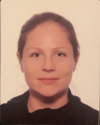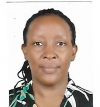Grace Kisitu Paul
ID: UNCST-2024-R004102
|
Universal2: Pharmacokinetics, safety and acceptability of a solid paediatric fixed-dose combination of darunavir/ritonavir (DRV/r) 120/20mg for children living with HIV
REFNo: HS4762ES
To evaluate the pharmacokinetics and safety of DRV/r 120/20 mg tablets in children greater than or equal to 3 years of age and weighing 10 to less than 25 kg
To evaluate the pharmacokinetics and safety of DRV/r 120/20 mg tablets in children greater than or equal to 3 years of age and weighing 10 to Less than 25 kg
To evaluate the acceptability of DRV/r tablets in children greater than or equal to 3 years of age and weighing 10 to less than 25 kg
To evaluate the short-term efficacy of the DRV/r 120/20 mg tablets in children greater than or equal to 3 years of age and weighing 10 to less than 25 kg
To describe RTV PK parameters as well as darunavir unbound plasma concentrations.
|
|
Uganda |
2024-08-22 11:45:22 |
2027-08-22 |
50 |
Children with HIV, from 3 years of age, requiring DRV/r:
• weighing 10 to less than 25 kg with 1 or 2 DRV resistance-associated mutations (RAM) *
Or
• weighing 10 to less than 20 kg requiring DRV/r, with no DRV RAM*
*DRV RAMs: V11I, V32I, L33F, I47V, I50V, I54M, I54L, T74P, L76V, I84V
|
Fondazione Penta ETS |
Medical and Health Sciences |
Clinical Trial |
Non-degree Award |

|
Agaba Katureebe Ishmael
ID: UNCST-2024-R004089
|
Getting a GRIP on Hypertension in Uganda: Giving Repetitive Isometric Exercise for Blood Pressure Control (GRIP in Uganda)
REFNo: HS4712ES
To assess knowledge, attitudes, and practices (KAP) about HTN and experience with IHT (if applicable) ,To measure HTN medication adherence for those prescribed HTN medication during their follow-up, which will be measured through pill counting (counting the remaining amount of pills for prescribed medication).,To assess the need for HTN medication at endline, as per clinical and MOH guidelines, which will be measured through changes in BP levels at week 12,To evaluate the effects of Isometric Hand Training (IHT) on resting diastolic Blood Pressure when compared to standard care after 12 weeks ,To evaluate the effects of Isometric Hand Training (IHT) on resting Systolic Blood Pressure when compared to standard care after 12 weeks ,To determine the efficacy of Isometric Hand Training (IHT) in a population of Hypertension (HTN) patients compared to standard care after 12 weeks of care,
|
Jinja, Ivunamba
|
Uganda |
2024-08-22 11:38:26 |
2027-08-22 |
250 adult participants |
We intend to enroll 250 adult participants men and women aged 18 years and above. Participants will be persons who seek care at the Soft Power Mukagwa Allan Stone community clinic in Kyabirwa jinja. These come from Jinja and the neighboring districts of Iganga, Luuka, Kamuli and Mayuge in East Central sub-region. The area is predominantly inhabited by Basoga and then minority Baganda, Bagisu, Banyole etc.
Eligibility criteria
Inclusion criteria are: 1) diagnosis of stage 1 HTN (BP >140-159/90-99 mmHg ), which is based on the clinic and MOH definitions , 2) not currently taking HTN medication, 3) not having been on HTN medication in the past 3 months, and 4) age > 18 years and older.
Exclusion criteria are: 1) diagnosis of stage 1 HTN and currently taking HTN medication, 2) diagnosis of stage 2 HTN, 3) diabetes, 4) history of recent myocardial infarction (in the past year), 5) congestive heart failure, 6) complete heart block, 7) unstable angina, 8) Glomerular Filtration rate of 90 or lower, 9) any pregnancy associated HTN, 10) any limitation (e.g., limited hand mobility) preventing proper performance of IHT exercise, and 11) any other condition that alters autonomic nervous system function.
|
Canadian Institutes of Health Research (CIHR) |
Medical and Health Sciences |
Clinical Trial |
Non-degree Award |

|
Proscovia Nabunya
ID: UNCST-2019-R000970
|
Testing the Feasibility and Acceptability of a Combination Intervention to Address Mental Health among Refugee Youth in Uganda
REFNo: SS2834ES
This proposed two-year study will be conducted in two phases. The first phase seeks to understand whether the COVID-19 pandemic had differential impact on refugee youth living in different settings. The second phase will test the feasibility and acceptability of an innovative combination intervention that has not been previously tested among refugee youth to address psychological problems that have increased since the onset of the COVID-19 pandemic.
Aim 1. To examine the mental health impact of COVID-19 on refugee youth living in Bidibidi refugee settlement compared to refugee youth living in urban centers (Arua town) in northern Uganda.
Aim 2. To test the feasibility, acceptability and preliminary short-term impact of an innovative intervention combining the youth readiness intervention (YRI) with youth development accounts and financial literacy training (YDA-FLT) to address the mental health impact of COVID-19 among refugee youth living in Bidibidi refugee settlement in northern Uganda.
|
|
Uganda |
2024-08-19 11:03:04 |
2027-08-19 |
200 |
The total sample size needed for the Refugee Youth COVID-19 study is 200 refugee youth, 15 to 24 years of age. Specifically, we will recruit 100 refugee youth from the five zones within Bidibidi Refugee settlement and another 100 youth among refugee youth living in Arua town (urban center). Youth will be recruited from centrally located ration distribution centers in the settlement, through churches, and youth advocacy groups led by refugee youth in Arua town that we will partner with. For the pilot RCT component, we will only include the 100 participants in Bidibidi refugee settlement with 50 randomized to the treatment group and the other 50 randomized to usual care group. |
Washington University in St. Louis |
Social Science and Humanities |
Clinical Trial |
Non-degree Award |

|
Peter Olupot-Olupot Olupot
ID: UNCST-2020-R014798
|
SMAART-MAP trial
Severe Malaria A Research and Trials
consortium - Multisite Adaptive Platform
trial
REFNo: HS4547ES
OBJECTIVES
The objective of the SMAART-MAP trial is to identify promising adjunctive therapies to take forward into a large Phase III trial in severe malaria with a mortality endpoint. The adaptive platform design enables additional domains to be added so a range of adjunctive therapies can be tested, across multiple clinical presentations of severe malaria, in a timely manner.
PRIMARY OBJECTIVE(S)
To explore within each domain the therapeutic efficacy of the intervention using an early indicator such as a biomarker or clinical assessment at 24-72 hours.
SECONDARY OBJECTIVE(S)
To assess the impact of the interventions on clinical outcomes (readmission and
mortality) on all children 28 days and 90 days after randomization
To assess the impact of the interventions on Grade 3 or 4 adverse events, and adverse
events of any grade related to the interventions or comparators.
To assess the impact of proposed definitions for severe malaria based on platelet counts
≤150,000/µL and plasma pfHRP2 concentrations ≥800 ng/mL on differences between
randomized groups
In a sub study, to determine the performance characteristics of a POC pfHRP2 test
compared with quantitative plasma pfHRP2 concentrations determined from plasma.
|
Mbale, North central
Soroti, Pioneer Ward
Agago, Oreet
|
Uganda |
2024-08-16 11:01:14 |
2027-08-16 |
150 per domain |
Hospitalized children with severe malaria |
Imperial College London |
Medical and Health Sciences |
Clinical Trial |
Non-degree Award |

|
VINCENT MUBANGIZI
ID: UNCST-2024-R004232
|
Opti-MaP (Optimising Implementation of Maternal and Perinatal Death Surveillance and Response to prevent avoidable future deaths in Uganda
REFNo: HS4630ES
To review existing tools, develop and adapt a harmonised toolbox of resources to optimise MPDSR implementationTo co-design customised an "intervention package" using the toolboxTo evaluate effectiveness and cost-effectiveness of the "customised intervention package" to reduce perinatal and maternal mortalityTo develop and adapt a harmonised toolbox of resources to optimise MPDSR implementation
|
Kamwenge, All parishes
Kyenjojo, All parishes
Lyantonde, All parishes
|
Uganda |
2024-08-06 18:02:24 |
2027-08-06 |
For work packages 2-7, the sample size will be determined when the interviewers reach a point of saturation. For the intervention phase (work package 8), the estimated sample size is 4032. |
Adult males and females plus emancipated minors in the study area regardless of their tribe will be involved in the study. We will also interview key stake holders in the central ministries and bodies.
We will interview persons who have lost a women due to pregnancy related causes or had a still birth or a baby died within 28 days of birth |
Merlin L Willcox |
Medical and Health Sciences |
Clinical Trial |
Non-degree Award |

|
Cissy Kityo
ID: UNCST-2021-R013663
|
A Phase 4, Open-Label, Rollover Study to Provide Continued Access to Cabotegravir Long-acting Injection and Rilpivirine Long-acting Injection to Participants Living with Human Immunodeficiency Virus Type 1 (HIV-1) Infection Who Participated in Long-Acting Combination Therapy Studies.
REFNo: HS4452ES
The secondary objective is to assess the long-term safety and tolerability of CAB LA + RPV LA by evaluating the incidence of serious adverse events (SAEs), pregnancies, adverse events (AEs) leading to discontinuation of CABLA +RPV LA, and AEs considered to be related to the study intervention.,The primary objective of the study is to provide continued CAB LA + RPV LA access to participants who were enrolled and treated with CAB LA + RPV LA in the parent studies, and who, at the time of roll-over, experience and are expected to continue to experience clinical benefit from this treatment.,
|
Wakiso, Katabi
Wakiso, Lubowa
Kampala, Mulago
Kabarole, Buyinga
|
Uganda |
2024-08-06 17:32:50 |
2027-08-06 |
710 in Uganda |
Virologically suppressed adults who have had a detectable HIV viral load in prior 2 years of taking first-line ART or who have disengaged from HIV care. |
Janssen-Cilag International NV |
Medical and Health Sciences |
Clinical Trial |
Non-degree Award |

|
alfred bulamu
ID: UNCST-2023-R008638
|
Uganda Translational Breast Cancer Screening Research Center with Innovations in MRI and Genetic Testing.
REFNo: HS4689ES
Implementation of breast MRI with genetic testing as BC screening method for women at high risk of BC by July 2029 (Phase 6) , Continuous Trainings for radiologists, radiographers and laboratory staffs on the modern technologies of MRI and Genetic testing (phase 3 to phase 6) ,Evaluating the feasibility of screening BC using MRI and genetic testing for high risk women by December 2028 (phase 5),Large scale education of the community about BC by July 2028 (phase 3 and phase 4).,Large scale determination of the utility of genetic testing as a screening modality for BC in Uganda by perform mutational genetic analysis for women at high-risk aged19 years to 80 years by July 2028 (phase 3 and phase 4) , Large scale determination of the utility of quantitative breast MRI for screening women at high risk BC aged 19 years to 80 years by July 2028 (phase 3 and phase 4) ,Training of the users on equipment i.e. Radiologists, Radiographers and laboratory staffs by 2025 (phase 2) ,Securing and installation of lab equipment for genetic testing by 2025 (Phase 2,Securing and installation of MRI with Breast coils by July 2025 (Phase 2),To build capacity for 20 laboratory health care workers in genetic testing technologies by December 2023 (phase 1).,To build capacity for 30 radiology health professionals in modern breast Imaging with MRI by December 2023 (Phase 1),To determine the utility of quantitative breast MRI for screening women at high risk breast cancer aged 19 years to 80 years by July 2024 (phase 1),To determine the utility of genetic testing as a screening modality for BC in Uganda by perform mutational genetic analysis for women at high-risk of BC aged 19 years to 80 years, by July 2024 (phase1),To build a long-lasting infrastructure for research, clinical screening in Uganda and training using modern technologies. ,To offer improved access to Breast Cancer screening in Uganda through quantitative MRI and genetic testing research center,
|
All Districts, All parishes
|
Uganda |
2024-08-06 17:27:31 |
2027-08-06 |
100 participants |
All women at the risk of breast Cancer between the Ge of 19 year to 80years of all the tribes in the different regions |
Kiphart Foundation |
Medical and Health Sciences |
Clinical Trial |
Non-degree Award |

|
Moses Oketch
ID: UNCST-2024-R004313
|
Long-Term Impacts of Improved Childhood Literacy
REFNo: SS2796ES
Economic situation,
|
Amolatar,
Dokolo,
|
UK |
2024-08-05 14:01:33 |
2027-08-05 |
6581 |
Former participants of a study on the impact of an early-grade literacy intervention. The study was implemented from 2009 to 2011. The respondents are aged between 19 and 24 years old, with an average age of 21 years. |
Center for Global Development |
Social Science and Humanities |
Clinical Trial |
Non-degree Award |

|
Jenny Löfgren
ID: UNCST-2024-R005428
|
Outcomes of paediatric inguinal hernia repair performed by surgeons versus medical officers
REFNo: HS4508ES
Calculate and compare costs and cost-effectiveness between the two groups. ,Compare patient related outcomes between the group that has been operated on by medical officers versus those who were operated by general surgeons. ,The general objective of the proposed study is to investigate the possibility of task sharing between general surgeons and medical officers in inguinal hernia repair in children in Uganda. ,
|
Soroti,
Mubende,
Iganga,
|
Sweden |
2024-07-23 15:30:50 |
2027-07-23 |
341 |
Children, both girls and boys, 1-12 years old. |
Swedish Research Council |
Medical and Health Sciences |
Clinical Trial |
Degree Award |

|
Nura Izath
ID: UNCST-2022-R009201
|
Autothermo-a wearable continuous temperature measuring bracelet with a central display screen.
REFNo: HS3034ES
To assess the performance of Autothermo- a wearable continuous temperature measuring bracelet and a central display screen in comparison to the standard thermometer.,To assess the feasibility and acceptability of Autothermo among health workers and parents/caregivers of admitted neonates at Mbarara Regional Referral Hospital(MRRH).,
|
Mbarara, Kamukuzi
|
Uganda |
2024-07-22 16:57:35 |
2027-07-22 |
The sample size of the health workers: Convenient sample of 4 out of 6 health workers engaged in the management and care of newborns admitted at Neonatal Intensive Care Unit-MRRH will be enrolled in the study. These study participants who will be nurses on duty will observe the use of Autothermo, ask a few questions and document findings at the end of each shift. The remaining two nurses will be recruited as study research nurses who will enroll and use Autothermo to monitor temperatures of the admitted newborns during the study period. The sample size for parents or caregivers will be calculated basing on the Kish and Leslie where P (0.5) will be the probability of parents or caregivers who will express willingness to have their newborns’ temperatures monitored with Autothermo and q (1-p) will be the probability of those who will not express willingness to use Autothermo. The study will use a precision of 0.126 and a Z of 1.96 giving a total of 60 parents or caregivers to be recruited into the study. Taking |
Feasibility and Acceptability of Autothermo: The study will include health workers and parents or primary caregivers of newborn. Parents and caregivers who are 18 years and above will be recruited and all health workers in the Neonatal Intensive Care Unit. The parents or caregivers will be informed that the Autothermo bracelet will be removed at any time at their request.
Autothermo Performance Assessment: All neonates (0 to 28 days) admitted to the neonatal unit of MRRH during the study period will be screened for inclusion into the study.
|
Ministry of ICT and National Guidance |
Medical and Health Sciences |
Clinical Trial |
Non-degree Award |

|
Grace Kisitu Paul
ID: UNCST-2024-R004102
|
UNIVERSAL1: Pharmacokinetic study of an optimized dose ratio of
dolutegravir/emtricitabine/tenofovir alafenamide fumarate: expediting a UNIVERSAL first line regimen for all children living with HIV in Africa
REFNo: HS4280ES
Primary objective:
To evaluate the pharmacokinetics and short-term safety of DTG and FTC/TAF administered to children living with HIV using a novel dose ratio
Secondary objective:
To evaluate the short-term efficacy of DTG and FTC/TAF
formulations in children using a novel dose ratio
|
|
Uganda |
2024-07-19 3:45:20 |
2027-07-19 |
50 |
Children aged between 28 days and ≤10 years old weighing ≥3 to <25kg diagnosed with HIV.
|
Fondazione Penta ETS |
Medical and Health Sciences |
Clinical Trial |
Non-degree Award |

|
Janet Nakigudde
ID: UNCST-2019-R000444
|
PROMOTING MENTAL HEALTH OF TEACHERS AND CAREGIVERS USING A PERSONALIZED MHEALTH TOOLKIT IN UGANDA
REFNo: HS4431ES
3. To examine feasibility of mWEL-T and mWEL-P with parents and teachers from urban and rural regions (including examining feasibility of the implementation procedures and intervention efficacy) (n=160, 80 parents and 80 teachers from urban and rural regions).,To conduct a user-centered testing study to optimize usability of the Teacher and Parent versions of mWEL- mWEL-T and mWEL-P,1. To build a school system capacity (by establishing a cross-discipline digital health leadership & learning collaborative (n=10) and training a group of peer-community health workers (P-CHW) (n=30; 15 peer teachers and 15 peer parents) to implement the mWEL that is developed,The aim of the study is to test mWEL a newly developed mobile app and user-engagement strategies for mental health management and promotion targeting teachers and parents,
|
Kampala, kibuli
Nakaseke, Nakaseke
|
Uganda |
2024-07-17 14:03:01 |
2027-07-17 |
For the proposal sample size N=160 for the full sample |
The study will enroll parent, teachers and caregivers of children.
We shall consider parents who are at least 18 years old, and have a child aged 6-14 years in the enrolled school |
This study is sponsor by the United States National Institute of Mental Health through a collaboration with New York University, Department of Population Health, New York School of Medicine and Makerere University College of Health Sciences, Department of Psychiatry |
Medical and Health Sciences |
Clinical Trial |
Non-degree Award |

|
Eugene Ruzagira
ID: UNCST-2023-R008282
|
Implementing oral (event-driven and daily) and long-acting Pre-exposure
prophylaxis (PrEP) in mobile men in Sub-Saharan Africa: a phase 3b, open-label, hybrid type 2 implementation and effectiveness trial (MOBILE MEN)
REFNo: HS4366ES
Overall Objective
To assess effectiveness and implementation of long-acting cabotegravir (CAB-LA) and oral Truvada (both daily and event driven) through comparison of uptake, retention in care, coital coverage, and participant choice.
|
Masaka, Masaka
|
Uganda |
2024-07-02 15:08:06 |
2027-07-02 |
400 mobile men. |
HIV negative men aged 18+ years in South
Africa and Uganda. Men who are mobile for work, and in the past 6-months have travelled for work or to find work and spent at least one night away from home for work-related purposes. Men male at birth, able and willing to provide informed consent and willing to have an HIV test. |
MRC/UVRI &LSHTM Uganda Research Unit |
Medical and Health Sciences |
Clinical Trial |
Non-degree Award |

|
SABRINA KITAKA BAKEERA
ID: UNCST-2020-R014290
|
SEARCH2: A Randomized Control Trial of Telephonic Reminders for HPV Vaccination among Adolescent Girls in Kampala, Uganda
REFNo: HS3929ES
General Objective
To conduct a randomized control trial to assess the impact of text message and automated phone reminders on HPV vaccination.
Specific Objectives:
1.To assess the impact of text message and automated phone reminders on HPV vaccination.
Sub-objectives include:
1) To assess if text message and automated phone reminders were equally effective
2) To examine subgroup effects (girl: age, site, school status [in or out of school], grade, relationship with caregiver; caregiver: age, education, employment, income, marital status, distance to health facility, language), when possible depending on the degree of variability observed
3) to assess for possible additive or subtractive effects of receiving two series of message for families of girls who may have been in the intervention for both initiation and completion
|
Kampala, Adolescent Clinic
Kampala, Kawala HC 3
Kampala, Kiswa HC 3
Kampala, Kisenyi HC 3
|
Uganda |
2024-07-02 12:45:18 |
2027-07-02 |
296 |
Target population: Families of adolescent girls in Uganda
Study population: Families of adolescent girls who visited any of the following health centers: Kisenyi HC IV, Kiswa HC III, or Kawaala HC III or Makerere/Mulago/Columbia Adolescent Health Clinic at Mulago National Referral Hospital
Accessible population: Families of adolescent girls who visited any of the following health centers: Kisenyi HC IV, Kiswa HC III, or Kawaala HC III or Makerere/Mulago/Columbia Adolescent Health Clinic at Mulago National Referral Hospital who meet the following selection criteria.
|
National Institutes of Health USA |
Medical and Health Sciences |
Clinical Trial |
Non-degree Award |

|
Elizabeth namukwaya namukwaya
ID: UNCST-2021-R013177
|
PARASTOP-Paracetamol with strong opioids
REFNo: HS4423ES
To explore whether placebo with strong opioids compared to paracetamol with strong opioids changes pain intenisty for different doses of opioids, different cancers and quality of lifeintensity,To establish whether placebo with strong opioids compared to paracetamol with strong opioids changes opioid related side-effects,changes in opioid requirements and global rating of improvement,To establish whether placebo with strong opioids compared to paracetamol together with strong opioids provides non-inferior analgesia for cancer related pain,To establish whether the analgesic efficacy of strong opioids after withdrawal of paracetamol is non-inferior compared the analgesic efficacy of strong opioids used together with paracetamol for cancer-related pain.,
|
Kampala, Mulago
Kampala, makinndye
|
Uganda |
2024-07-02 12:41:56 |
2027-07-02 |
25 cases and 25 controls |
Participants are eligible to be included in the study only if all of the following criteria apply:
1. Participant must be ≥ 18 years of age inclusive, at the time of signing the informed consent.
2. ≥50 kg study dose of paracetamol favours that weight
3. Participants who are under palliative care or oncology service review
4. Diagnosis of metastatic cancer. This includes all incurable solid malignancy in an advanced stage, either locally advanced or metastatic. This also includes malignant lymphoma in the palliative setting and multiple myeloma with bone disease.
5. Clinician-predicted life expectancy >2 months
6. Receiving daily regular strong opioids for cancer pain
7. Receiving stable scheduled opioid dose last 48 hours*
8. Receiving paracetamol 1 gram x three or four times a day for at least five days
9. Average pain intensity past 24 hours ≥ 2 and ≤ 7 (NRS 0-10)*
10. Able to take study drug/placebo as tablets
11. Able to comply with all study procedures
12. Capable of giving signed informed consent as described in Appendix 1 which includes compliance with the requirements and restrictions listed in the informed consent form (ICF) and in this protocol
* It is allowed to repeat procedure within the screening period without considering the participant being a rescreen
5.2. Exclusion Criteria
Participants are excluded from the study if any of the following criteria apply:
1. History of allergy or hypersensitivity to any of the active substances or excipients in the study drug
2. Known severe liver or renal failure equivalent with CTCAE Grade 3 or 4* precluding continuation of paracetamol. (*Common Terminology Criteria for Adverse Events (CTCAE) Version 5.0)
3. Participants receiving subcutaneous, intravenous, intrathecal, or epidural opioid therapy
4. Participants receiving systemic anticancer treatment during the intervention period if they are anticipated to have increasing pain or other symptoms related to the treatment
5. Co-enrolment in other drug trials. Participants will not be enrolled in any other on-going interventional clinical trial. Study participants may be enrolled in non-interventional research (e.g. questionnaire, tissue collection studies)
6. Previously enrolled in this study
7. Pregnant or lactating women
|
SouthEastern Norway Regional Health Authority |
Medical and Health Sciences |
Clinical Trial |
Non-degree Award |

|
DAVID KITYA
ID: UNCST-2022-R009620
|
Assessment of Accuracy, Precision, and Feasibility of a Handheld Near-Infrared Light Device (InfraScanner 2500™) in Detecting Intracranial Hemorrhage in Patients Admitted to Mbarara Regional Referral Hospital
REFNo: HS4141ES
Use these findings to evaluate the InfraScanner 2500™\'s ability to accurately detect intracranial hemorrhages in darker-skinned populations within LMICs. ,Determine whether the InfraScanner 2500™ detects intracranial hemorrhage (ICH) with adequate precision relative to CT scans to be used as an effective triage tool to prioritize imaging and need for level of clinical monitoring in an African, LMIC population.,To demonstrate that the InfraScanner 2500™ is capable of detecting and ruling out intracranial hematomas at rates similar to CT scan in patients hospitalized at Mbarara Regional Referral Hospital who have sustained or are suspected to have sustained head trauma.,
|
Mbarara, Kamukuzi
|
Uganda |
2024-06-24 0:30:16 |
2027-06-24 |
180 |
12 years and above |
Duke Global Neurology Neurosurgery |
Medical and Health Sciences |
Clinical Trial |
Non-degree Award |

|
Hannah Kibuuka
ID: UNCST-2020-R014355
|
PROTECT-APT 1 _ Master Protocol for Early Treatment and Post-Exposure Prophylaxis of COVID-19 Adaptive Platform Trial V3.0 dated 02 June 2023 and Appendix C entitled “A phase 2 safety and efficacy study of upamostat for early outpatient treatment of COVID-19” V3.0 dated 01 June, 2023
REFNo: HS3116ES
To determine if early treatment with upamostat can shorten time to sustained symptom alleviation or resolution in participants infected with SARS-CoV-2.
|
Kabarole, Baza
|
Uganda |
2024-06-24 0:12:16 |
2027-06-24 |
40 |
Adult male and female participants aged 18 years and above |
FHI Clinical |
Medical and Health Sciences |
Clinical Trial |
Non-degree Award |

|
Jonathan Izudi
ID: UNCST-2019-R000469
|
Integrating Tuberculosis Treatment into Community Pharmacies to improve TB/HIV outcomes in Uganda: the Community Pharmacy Tuberculosis Treatment (COPHAT) study
REFNo: HS4397ES
To evaluate the implementation and preliminary effectiveness of integrating TB treatment into community pharmacies among people with TB/HIV.,To adapt a person-centered strategy for integrating TB treatment into community pharmacies using a human-centered design methodology.,To explore the barriers and facilitators to integrating TB treatment into community pharmacies among people with TB/HIV.,The main objective of this Community Pharmacy Tuberculosis Treatment (COPHAT) study is to develop and pilot an implementation strategy focused on integrating TB treatment into community pharmacies among people with TB/HIV in Kampala, Uganda. ,
|
Kampala, Kisugu
Kampala, Kisenyi
Kampala, Kaawala
Kampala, Kitebi
Kampala, Komamboga
Kampala, Kiswa
|
Uganda |
2024-06-21 17:46:35 |
2027-06-21 |
126 |
People with TB/HIV, ART focal persons, TB focal persons, MoH officials, and Community Pharmacy health workers, aged 18 years and over, irrespective of tribe. |
National Institutes of Health |
Medical and Health Sciences |
Clinical Trial |
Non-degree Award |
.jpg)
|
Cissy Kityo
ID: UNCST-2021-R013663
|
A Phase 2a/2b Study Evaluating Safety, Immunogenicity, and Therapeutic Efficacy of ID93 + GLA-SE Vaccination in Participants with Rifampicin-Susceptible Pulmonary TB
REFNo: HS3834ES
1.2 Secondary Objectives 1.2.1 Phase 2a and 2b: To evaluate the proportion of participants with a quantifiable RS ratio after therapeutic vaccination with ID93 + GLA-SE compared to placebo. 1.2.2 Phase 2a: To evaluate the kinetics of cellular immunogenicity of ID93 + GLA-SE through 12 months post second dose of study product. 1.2.3 Phase 2a: To evaluate the kinetics of humoral immunogenicity of ID93 + GLA-SE through 12 months post second dose of study product. 1.2.4 Phase 2a: To evaluate innate immune changes in response to ID93 + GLA-SE through 2 weeks post second dose of study product. 1.2.5 Phase 2b: To compare therapeutic vaccination with ID93 + GLA-SE, to placebo, with respect to the proportion of participants with TB-related unfavorable outcomes at 540 days after study entry, which is approximately 18 months after start of TB treatment, in subgroups defined by: Hard-to-treat phenotype and not hard-to-treat phenotype, where hard-to-treat phenotype is defined as smear Grade ≥3 and cavitary disease on chest radiograph at TB diagnosis.1.3 Exploratory Objectives 1.3.1 Phase 2a: To compare therapeutic vaccination with ID93 + GLA-SE to placebo, with respect to: • The safety and immunogenicity of ID93 + GLA-SE in participants living with and without HIV. • The quantitative RS ratio at time points relative to vaccination and TB treatment as indicated in the Schedule of Evaluations (SOE). • The magnitude and quality of immune responses with respect to the composition of the intestinal microbiota. 1.3.2 Phase 2b: To compare therapeutic vaccination with ID93 + GLA-SE to placebo, with respect to the proportion of participants with TB-related unfavorable outcomes at 540 days after study entry, which is approximately 18 months after start of TB treatment, adjusted for • Pharmacokinetics (PK) assessments of first-line TB drugs (exposure) during TB treatment as per the SOE. • Levels of participant adherence to standard of care (SOC) TB treatment measured using self-reporting and urine acetyl-isoniazid (AcINH) from start to end of TB treatment. 1.3.3 Phase 2b: To compare therapeutic vaccination with ID93 + GLA-SE to placebo, with respect to the proportion of participants with TB-related unfavorable outcomes at 540 days after study entry, which is approximately 18 months after start of TB treatment, stratified by bacterial burden at start of TB treatment. 1.3.4 Phase 2a and 2b: To develop the composite predictive model of TB drug response by using measures of adherence, drug exposure (PK), immune response, gut microbiota, and participant phenotype. 1.3.5 Phase 2a and 2b: To compare therapeutic vaccination with ID93 + GLA-SE to placebo, with respect to proportion of participants with sputum culture conversion at baseline at time of randomization and at Step 2, Days 30, 120, and 150, which are approximately 2, 5, and 6 months after start of TB treatment. 1.3.6 Phase 2a and 2b: To compare therapeutic vaccination with ID93 + GLA-SE to placebo, with respect to cumulative relapse from end of TB treatment up to end of study follow-up, that is, Step 2, Days 420, 450, 480, and 510, for Groups 1, 2, 3 (&5), and 4 (&5), respectively. 1.3.7 Phase 2a and 2b: To compare therapeutic vaccination with ID93 + GLA-SE to placebo, with respect to lung function and health-related quality of life, as measured by spirometry and the St. George’s Respiratory Questionnaire. 1.3.8 Phase 2a and 2b: To compare the within-person change in lung function tests over time from the first dose of therapeutic vaccination with ID93 + GLA-SE to placebo. 1.3.9 Phase 2a and 2b: To compare therapeutic vaccination with ID93 + GLA-SE to placebo, with respect to resolution of transcriptomic biomarkers of TB disease. 1.3.10 Phase 2b: To identify correlates of protection for unfavorable TB outcomes. 1.3.11 Phase 2b: To estimate the effect of the vaccine on the proportion of participants with TB-related unfavorable outcomes among participants living with and without HIV. 1.3.12 Phase 2a and 2b: To conduct analyses related to furthering the understanding of TB, HIV, immunology, vaccines, and clinical trial conduct.,1.1 Primary Objectives 1.1.1 Phase 2a and 2b: To evaluate safety of a two-dose ID93 + GLA-SE vaccine regimen administered 60 days apart on Step 2, Days 0 and 60, with TB treatment administered, at approximately: 1.1.1.1 Months 4 and 6 after start of TB treatment (Group 1) 1.1.1.2 Months 3 and 5 after start of TB treatment (Group 2) 1.1.1.3 Months 2 and 4 after start of TB treatment (Group 3 and Group 5, if this vaccination schedule is adopted for Group 5) 1.1.1.4 Months 1 and 3 after start of TB treatment (Group 4 and Group 5, if this vaccination schedule is adopted for Group 5) 1.1.2 Phase 2a and 2b: To determine if therapeutic vaccination with ID93 + GLA-SE will increase the magnitude of vaccine-specific cellular responses compared to placebo at 2 weeks post second dose of study product. 1.1.3 Phase 2b: To estimate the effect of the vaccine on the proportion of participants with TB-related unfavorable outcomes (treatment failure, TB recurrence, or death due to TB) at Day 540 after study entry, which is approximately 18 months after start of TB treatment (Group 5 combined with either Group 3 or Group 4, depending on which vaccination schedule is selected for Group 5).,
|
Kampala,
|
Uganda |
2024-06-05 17:42:17 |
2027-06-05 |
100 |
Individuals with or without HIV, 18 years or older male or female (any tribe) with bacteriologically confirmed rifampicin-susceptible pulmonary TB receiving locally provided SOC TB treatment. Enrollment of participants living with HIV will be capped at 20% in each group. |
National Institute of Allergy and Infectious Diseases |
Medical and Health Sciences |
Clinical Trial |
Non-degree Award |

|
ERIC WOBUDEYA
ID: UNCST-2019-R001047
|
Shortened RegiMen for Drug-susceptIbLE TB in Children
REFNo: HS4030ES
Primary
1. To determine if an 8-week HPZM regimen in children with presumed drug-susceptible TB disease has non-inferior efficacy to 8-weeks of HRZ(E) plus 8- or 16-weeks of HR(E) for achieving treatment success.
2. To evaluate the safety of the 8-week HPZM regimen in comparison to the 16- or 24- week HRZ(E) regimen among children with and without HIV.
Secondary
1. To evaluate the tolerability of the 8-week HPZM regimen in comparison to the 16- or 24- week HRZ(E) regimen among children with and without HIV.
2. To determine the weight-banded dosing of rifapentine and moxifloxacin taken as part of the HPZM regimen.
3. To evaluate the palatability and acceptability of the 8-week HPZM regimen in comparison to the 16- or 24-week HRZ(E) regimen among children with and without HIV.
4. To evaluate adherence to the 8-week HPZM regimen in comparison to the 16- or 24- week HRZ(E) regimen among children with and without HIV.
5. To evaluate clinical and laboratory characteristics and drug exposures associated with unsuccessful treatment outcomes (treatment failure or death).
6. To evaluate the cost and cost-effectiveness of the 8-week HPZM regimen relative to the 16- or 24-week HRZ(E) standard of care regimen, using a societal approach.
Exploratory
1. To characterize rifapentine and moxifloxacin PK parameters in malnourished children.
2. To evaluate the effect of rifapentine or rifampin, taken as part of the HPZM or HRZ(E) regimen, on the PK of dolutegravir.
3. To evaluate virologic control (less than 200 copies/mL) at 24- and 48-weeks among children with HIV taking a dolutegravir-based ARV treatment regimen co-administered with either HPZM or HRZ(E).
4. To collect and store biospecimens from consented participants for the purpose of future TB research.
|
Kampala, mulago
|
Uganda |
2024-05-31 18:02:19 |
2027-05-31 |
150 |
Children less than 10 years of age |
Johns Hopkins University |
Medical and Health Sciences |
Clinical Trial |
Non-degree Award |

|
| View |
|
Sort By: |
|
|
|
| |
|











